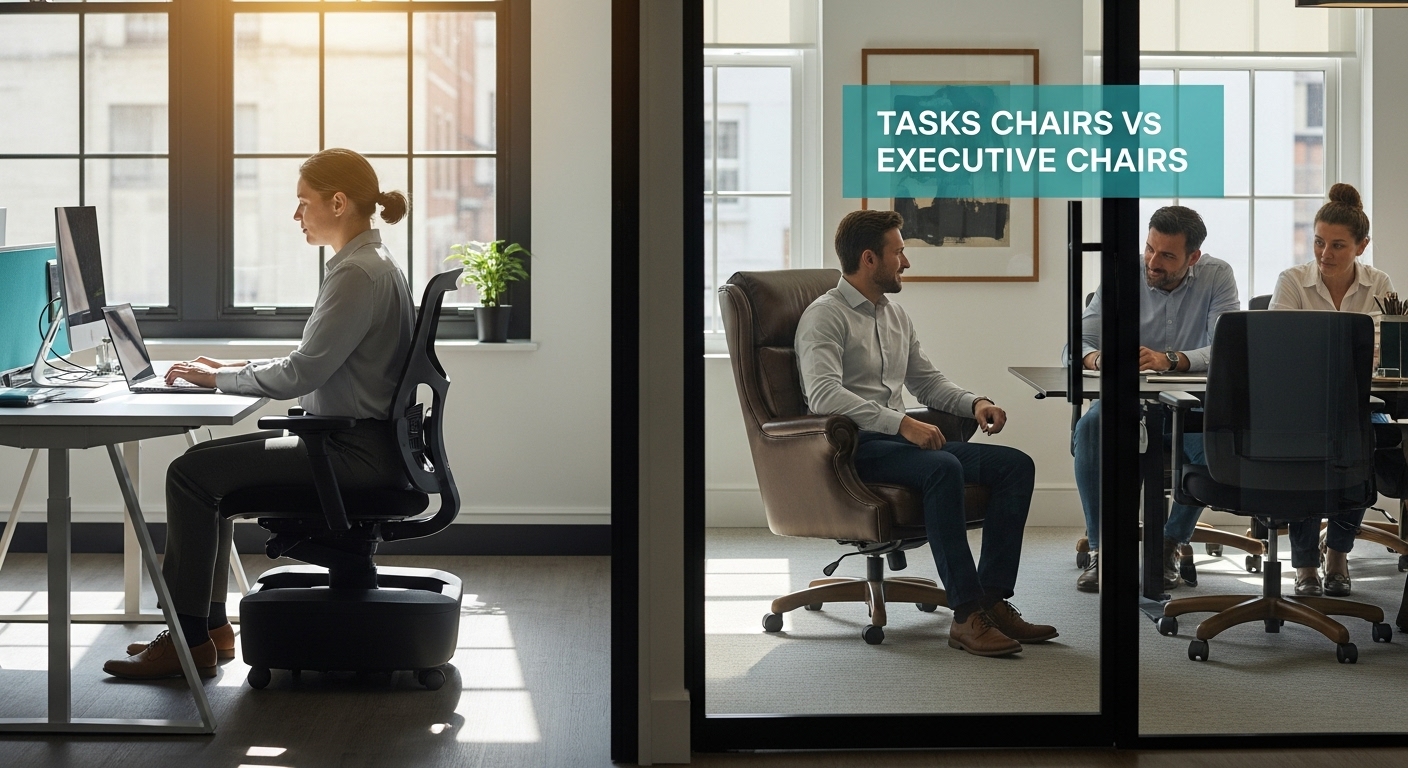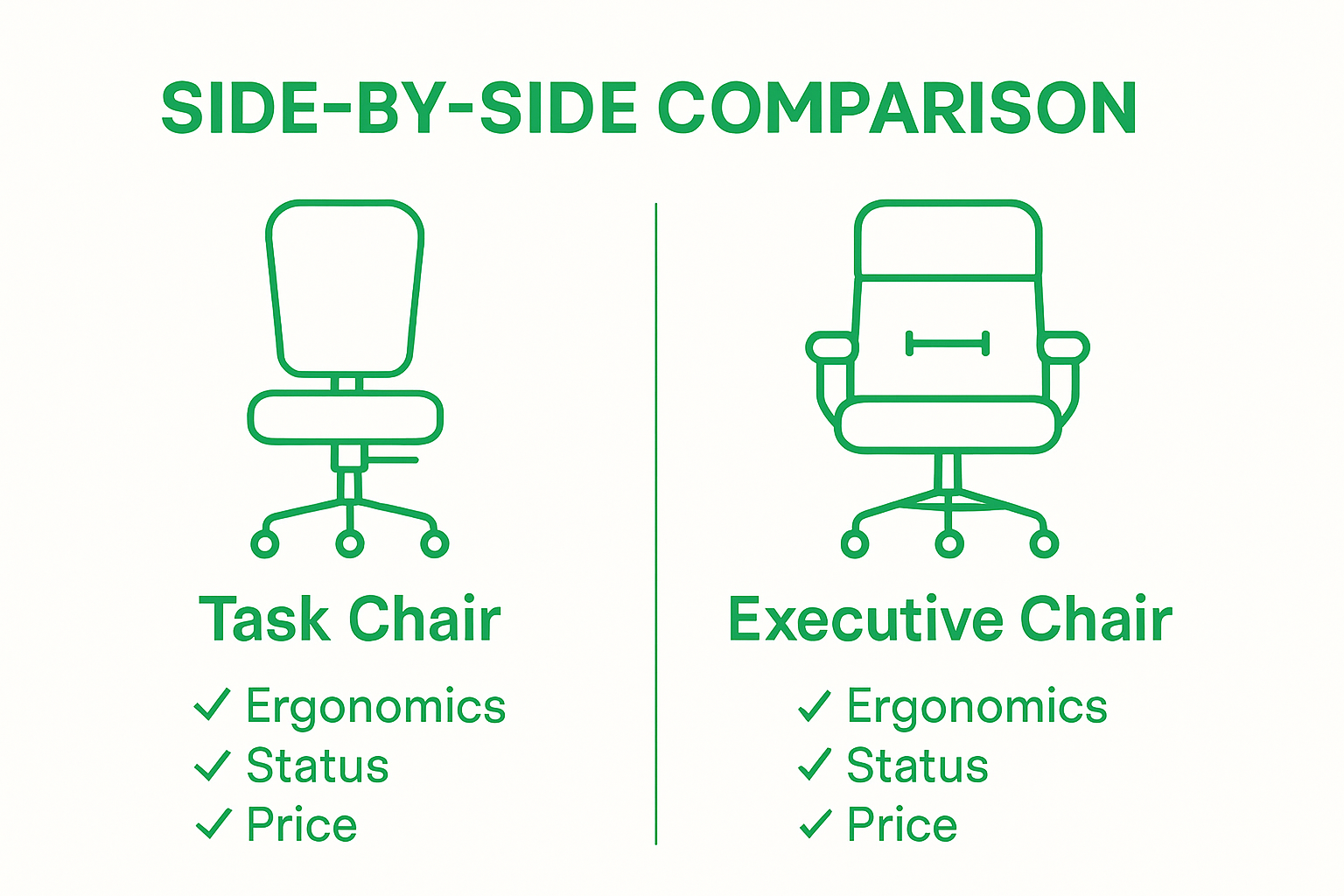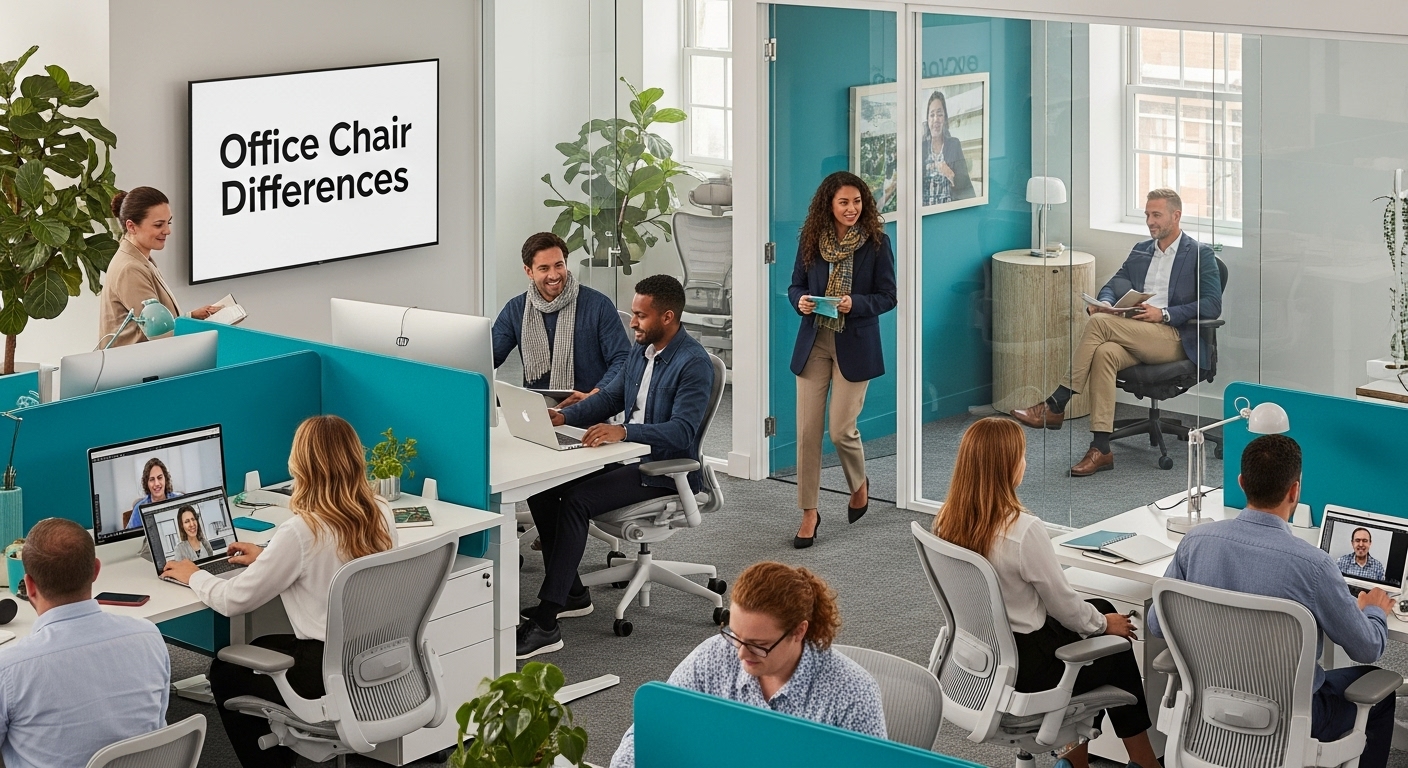Understanding Tasks Chairs vs Executive Chairs for Business
Sep 23, 2025
Understanding Tasks Chairs vs Executive Chairs for Business

Office furniture might look similar at first glance but the differences can be massive. Most folks do not realise that the wrong office chair can raise your odds of back pain and physical fatigue by over 60 percent. It gets even more interesting because the chair you choose does more than just affect your comfort. It shapes how others see you, your status at work, and even your daily focus.
Table of Contents
- What Are Task Chairs And Executive Chairs?
- The Importance Of Choosing The Right Office Chair
- How Task Chairs Improve Productivity And Comfort
- Executive Chairs And Their Impact On Workplace Image
- Key Differences Between Task Chairs And Executive Chairs
Quick Summary
| Takeaway | Explanation |
|---|---|
| Choose task chairs for flexibility. | Task chairs are lightweight and adjustable, ideal for dynamic office environments and prolonged desk use. |
| Select executive chairs for status. | Executive chairs enhance a professional image while providing luxurious comfort and support for leaders during meetings. |
| Prioritize ergonomic features for health. | Well-designed chairs alleviate back pain and improve posture, addressing common workplace health issues. |
| Chair choice impacts productivity. | Comfortable seating reduces physical fatigue, thereby boosting focus and efficiency in the workplace. |
| Consider your organizational needs. | Different roles require specific chair types; assess functionality and image when selecting office furniture. |
What are Task Chairs and Executive Chairs?
In the diverse world of office furniture, task chairs and executive chairs represent two distinct categories designed to meet different workplace needs. While both serve the fundamental purpose of providing seating, their design, functionality, and intended use vary significantly.
Understanding Task Chairs
Task chairs are ergonomically designed seating solutions primarily intended for employees who spend extended periods working at desks or workstations. These chairs prioritize functionality, comfort, and adaptability. Typically featuring adjustable components like seat height, armrests, and lumbar support, task chairs are engineered to support the human body during long working hours.
Key characteristics of task chairs include:
- Lightweight and compact design
- Multiple adjustable features for personalized comfort
- Affordable pricing suitable for open office environments
- Focus on practical functionality over aesthetic complexity
Task chairs are most commonly found in collaborative workspaces, call centers, administrative departments, and shared office environments where mobility and adaptability are crucial. Our comprehensive office chair buying guide provides further insights into selecting the right task chair for your workspace.
Executive Chairs: A Symbol of Professional Status
In contrast, executive chairs represent a higher tier of office seating, designed not just for comfort but also to convey professional status and leadership. These chairs are typically larger, more luxurious, and constructed with premium materials like high-quality leather or sophisticated mesh fabrics.
Executive chairs distinguish themselves through:
- Enhanced padding and cushioning
- Higher backrests providing superior support
- More elaborate design aesthetics
- Often featuring advanced ergonomic mechanisms
- Typically more expensive than standard task chairs
Used primarily by managers, directors, and senior professionals, executive chairs symbolize authority while providing exceptional comfort during lengthy meetings or strategic planning sessions.
While both chair types aim to support workplace productivity, their design philosophies reflect different organizational roles and ergonomic requirements. Understanding these distinctions helps businesses make informed furniture investment decisions that balance comfort, functionality, and professional image.
Below is a side-by-side comparison of the main characteristics found in task chairs and executive chairs, helping you understand how each type meets different workplace needs.
| Feature / Characteristic | Task Chair | Executive Chair |
|---|---|---|
| Typical Users | Employees at workstations | Managers, directors, senior professionals |
| Design Focus | Ergonomics, adaptability, mobility | Professional status, luxury, visual impact |
| Size | Lightweight, compact | Larger, heavier, robust |
| Common Materials | Breathable mesh, simple fabric | Leather, premium fabric, sophisticated finishes |
| Adjustability | Multiple ergonomic adjustments | Often advanced mechanisms, less customisable |
| Backrest Height | Mid-back | High-back |
| Price Range | Affordable/Cost-effective | More expensive/Premium |
| Main Use Environment | Open offices, collaborative workspaces | Private offices, boardrooms |
The Importance of Choosing the Right Office Chair
Selecting the appropriate office chair is far more than a mere aesthetic decision. It represents a critical investment in employee health, productivity, and overall workplace performance. The right chair can significantly impact an individual’s physical well-being, work efficiency, and long-term professional comfort.
Health Implications of Proper Chair Selection
Prolonged sitting has emerged as a significant health concern in modern workplaces. Poorly designed chairs can lead to numerous musculoskeletal problems, including chronic back pain, neck strain, and reduced circulation. 7 Tips for Choosing Comfortable Executive Chairs provides additional guidance on making informed seating choices.
Research demonstrates that inappropriate seating can contribute to several workplace health challenges:
- Increased risk of lower back disorders
- Higher likelihood of developing repetitive strain injuries
- Potential long-term posture-related complications
- Reduced overall physical comfort during work hours
Productivity and Performance Considerations
Beyond physical health, the right office chair directly influences workplace productivity. Ergonomically designed chairs support better body alignment, reduce physical fatigue, and enable employees to maintain concentration for extended periods. Comfortable seating translates into fewer distractions, minimized physical discomfort, and enhanced work performance.
Key performance benefits of investing in quality office chairs include:
- Improved employee focus and mental clarity
- Reduced physical strain and fatigue
- Enhanced overall workplace efficiency
- Lower likelihood of work-related physical interruptions
Businesses that prioritize employee comfort through strategic chair selection demonstrate a commitment to workplace wellness. This approach not only supports individual employee health but also contributes to a more positive, productive organizational culture. By understanding the profound impact of office seating, companies can make informed decisions that benefit both their workforce and overall operational effectiveness.
The following table outlines key health and productivity implications based on office chair selection, offering a clear overview of the physical and work-related impacts discussed.
| Aspect | Negative Consequences (Poor Chair) | Positive Outcomes (Well-Chosen Chair) |
|---|---|---|
| Musculoskeletal Health | Chronic back pain, neck strain, repetitive strain injuries | Improved posture, reduced back and neck strain |
| Circulation | Reduced circulation, discomfort during long hours | Better circulation, enhanced physical comfort |
| Workplace Productivity | Frequent distractions due to physical discomfort | Increased focus and work efficiency |
| Long-term Wellbeing | Potential for persistent posture issues | Enhanced long-term professional comfort |
How Task Chairs Improve Productivity and Comfort
Task chairs represent a sophisticated solution to modern workplace ergonomics, designed specifically to enhance employee performance and physical well-being. By integrating advanced design principles, these chairs transform sitting from a passive activity into an active support mechanism for professional productivity.
Ergonomic Design and Physical Support
The core strength of task chairs lies in their meticulously engineered ergonomic features. These chairs are constructed to adapt to individual body mechanics, providing customized support that minimizes physical strain during extended work periods. Learn more about budget-friendly office furniture solutions to understand how strategic investments can improve workplace comfort.
Critical ergonomic components that contribute to enhanced comfort include:
- Adjustable lumbar support maintaining natural spine curvature
- Dynamic seat mechanisms allowing micro-movements
- Breathable materials reducing heat and moisture accumulation
- Seat depth and width accommodating diverse body types
According to research from PubMed, chair design significantly influences user comfort, with specific control adjustments and backrest motion playing crucial roles in reducing physical fatigue.
Psychological and Performance Benefits
Beyond physical comfort, task chairs contribute to psychological well-being and cognitive performance. By eliminating physical discomfort, these chairs enable employees to maintain focus, reduce mental distraction, and sustain higher levels of concentration throughout work sessions.
Performance enhancement aspects of task chairs include:
- Reduced physical tension translating to improved mental clarity
- Minimized workplace discomfort leading to increased work engagement
- Enhanced ability to maintain consistent work rhythm
- Lower likelihood of interruptions caused by physical discomfort
Task chairs represent more than simple seating solutions they are strategic investments in human capital. By prioritizing employee comfort and physiological support, businesses can create environments that naturally promote productivity, creativity, and overall workplace satisfaction.
Executive Chairs and Their Impact on Workplace Image
Executive chairs transcend mere functional seating, serving as powerful visual symbols of organizational hierarchy, professional status, and corporate identity. These chairs represent more than a piece of furniture they are strategic communication tools that convey leadership, sophistication, and organizational culture.
Visual Representation of Organizational Hierarchy
In professional environments, executive chairs communicate unspoken narratives about leadership and organizational structure. Their design, materials, and aesthetic qualities instantly signal an individual’s professional standing and the company’s commitment to excellence. Explore the role of seating in effective office environments to understand how furniture choices reflect organizational dynamics.
Key visual elements that contribute to executive chair perception include:
- Premium leather upholstery signaling luxury and refinement
- High-back designs representing authority and leadership
- Sophisticated color palettes reflecting corporate branding
- Refined mechanical details demonstrating attention to quality
- Proportions that communicate confidence and professional stature
Psychological Impact and Professional Positioning
Beyond aesthetic considerations, executive chairs possess profound psychological dimensions. They create immediate visual impressions that influence professional interactions, client perceptions, and internal workplace dynamics. The chair becomes an extension of the professional’s personal brand and organizational representation.
Psychological impact factors of executive chairs include:
- Nonverbal communication of professional competence
- Subtle reinforcement of leadership credibility
- Creation of psychological comfort during critical meetings
- Projection of personal and organizational confidence
Executive chairs are strategic investments that extend far beyond physical comfort. They serve as silent ambassadors of professional identity, communicating organizational values, leadership quality, and commitment to excellence through their sophisticated design and meticulous craftsmanship.
Key Differences Between Task Chairs and Executive Chairs
While task chairs and executive chairs both serve seating purposes, they represent distinctly different approaches to workplace ergonomics, design philosophy, and professional functionality. Understanding these differences helps businesses make strategic furniture selections aligned with their organizational needs and workplace culture.
Structural and Design Characteristics
The fundamental distinctions between task and executive chairs extend far beyond mere aesthetic variations. Task chairs are engineered for versatility and adaptive functionality, while executive chairs emphasize prestige and authoritative presentation. Explore comprehensive insights on office chair selection to navigate these nuanced differences.
Key structural differences include:

- Backrest height: Task chairs typically feature mid-height backs, whereas executive chairs boast high backs
- Material composition: Task chairs utilize more breathable, lightweight materials
- Adjustability range: Task chairs offer more comprehensive ergonomic adjustments
- Visual complexity: Executive chairs feature more elaborate design elements
- Weight and stability: Executive chairs are generally heavier and more robust
Functional and Operational Distinctions
According to ergonomic research from PubMed, chair design significantly impacts user comfort and workplace productivity. Task chairs prioritize movement and adaptability, while executive chairs focus on creating a sense of stability and professional presence.
Operational differences encompass:
- Intended usage: Task chairs support varied work activities, executive chairs represent leadership spaces
- Movement capability: Task chairs enable more dynamic sitting positions
- Mechanical complexity: Executive chairs often feature more sophisticated tilt and recline mechanisms
- Customization potential: Task chairs offer greater personal ergonomic configuration
Ultimately, the choice between task and executive chairs depends on understanding organizational requirements, individual role expectations, and the specific functional demands of different workplace environments. By recognizing these nuanced differences, businesses can make informed decisions that balance comfort, functionality, and professional presentation.

Transform Your Workspace Today with the Right Chair Choice
Choosing between task and executive chairs does more than set the look of your office. It shapes your team’s comfort, health, and the professional image you project. Whether you are aiming to reduce workplace fatigue, support productive hours, or elevate your company’s presence with premium seating, the right solution matters. Let our range of ergonomic office chairs address your business’s pain points, from everyday desk work to empowering leadership roles. See how our expert guidance on task and executive chair selection supports workplaces just like yours.

Time to give your team the comfort and status they deserve. Visit Office Stock now to discover office chairs and workspace solutions designed for South African businesses. Upgrade today and experience better productivity and style in every corner of your office.
Frequently Asked Questions
What is the primary difference between task chairs and executive chairs?
Task chairs are designed for functionality and adaptability, focusing on ergonomic support for long hours at a desk. In contrast, executive chairs prioritize luxury, professional status, and enhanced comfort, often featuring premium materials and elaborate designs.
How can task chairs improve workplace productivity?
Task chairs enhance productivity by providing ergonomic support that minimizes physical strain, allowing employees to maintain focus and concentration. Their adjustable features help to create a comfortable sitting experience, reducing distractions related to discomfort.
What features should I look for in a task chair?
When selecting a task chair, consider adjustable lumbar support, seat height, armrests, and breathable materials. These features ensure personalized comfort and promote healthy posture during extended periods of sitting.
Why are executive chairs considered symbols of professional status?
Executive chairs are typically larger, more luxurious, and constructed from premium materials, which visually convey authority and leadership. Their sophisticated design and premium aesthetics enhance the professional image of the user, making them suitable for management and executive roles.
Recommended
- 7 Tips for Choosing Comfortable Executive Chairs - Office Stock
- Understanding the Office Chair Buying Guide for Every Business - Office Stock
- Office Stock: The Ultimate 2025 Guide to Changing Office Furniture on a Budget in South Africa - Office Stock
- Top Ergonomic Office Chairs in South Africa for 2025: A Buyer’s Guide - Office Stock
